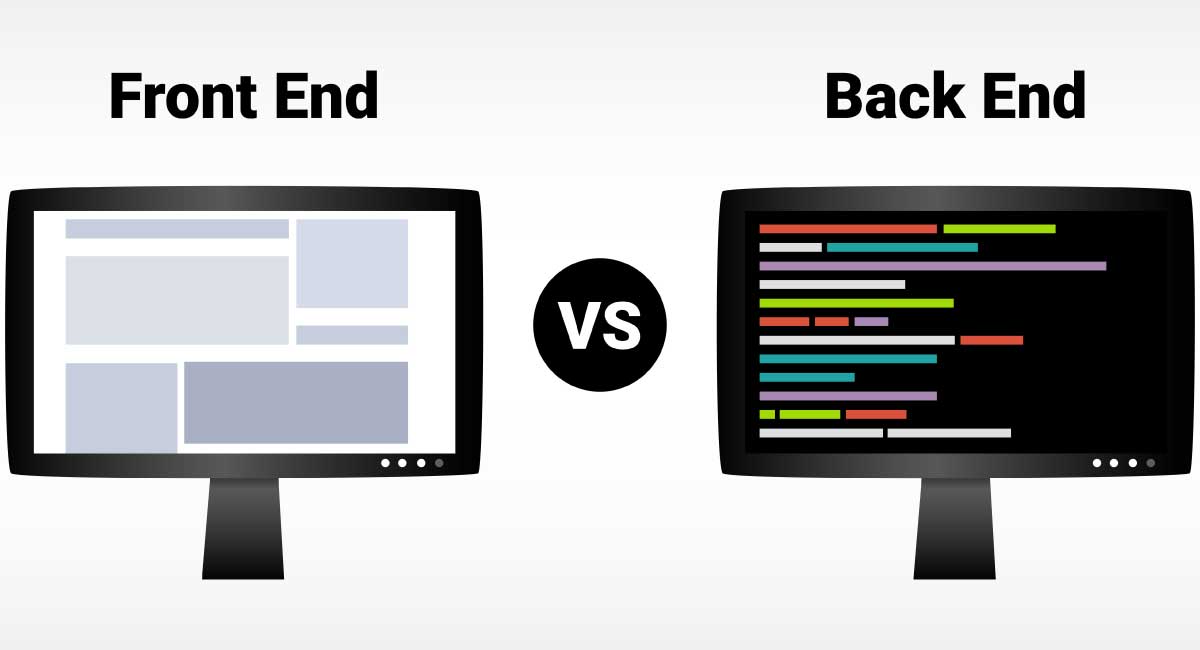Today’s digital age is defined by an exponential rise in the development of web applications worldwide, and there is no time like the present to jump into the field of web development. Selecting the right full stack web development course is the crux of making headway in this vibrant technical field.
To help aspiring developers understand more about this field, we will cover the two critical areas of full stack development—front-end and back-end in this article. We will take you through the scope of work, skills, and key elements of both types of development. We will also cover the criticality of understanding the difference between them.
What is Front-end Development?
Front-end development is creating features that the users can see and interact with. All the elements seen on an application or website that deal with how the application looks to the user come under the purview of front-end development.
For example, in designing a blog website, the front-end development involves coding for user interface and user experience, such as the appearance of the blog articles, the placement of the CTA buttons, and the inclusion of animation, images, and videos.
Also Read: What is Software Testing in Software Engineering?
The Key Elements of Front-end Development
Front-end development comprises two key elements—front-end programming languages and front-end frameworks and libraries.
Front-end languages are programming languages that can be used for front-end development. The language selected for coding depends on the application’s specific system and feature requirements. They allow the front-end developer to design algorithms and create tools to ensure a smooth user experience. Some of the most popular front-end languages are:
- JavaScript
- HyperText Markup Language (HTML)
- Cascading Style Sheets (CSS)
- ReactJS
- Vue
- Angular
- Django
- Swift
The second key element is the front-end frameworks and libraries. A front-end framework is a platform to create the front end of a website. It includes libraries, which are an assortment of ready-made codes and tools to design and build the UI and UX of the websites. The framework and libraries help the developer go directly to the design stage. This way, the developer does not need to reprogram the basic framework and codes. Here’s a list of some of the commonly used front-end frameworks:
- ReactJS
- Angular
- Ember.js
- Vue.js
- jQuery
- Svelte
- Foundation
- Preact
- Backbone.js
- Semantic-UI
What Does a Front-end Developer Do?
A front-end developer is responsible for making an application or website user-friendly. They use front-end languages to write code that helps design the website’s appearance. They ensure that the client’s ideas regarding the user interface and experience are creatively included in the application. The front-end developer also takes care of debugging the website, such as modifying the code to redirect the user to the homepage after completing online purchases. In short, whatever we can see and use on a website is created by a front-end developer.
Also Read: A Guide to Software Engineer Interview Questions
Essential Front-end Developer Skills
Front-end development requires unique skills that facilitate a streamlined user interface and user experience design. Let’s look at some of them:
- Programming languages: The developer should be knowledgeable about programming languages such as HTML, CSS, and JavaScript, which help in structuring the website, adding design elements, and ensuring interactive features, respectively.
- Responsive Design: the developer must be proficient in creating a responsive design that can change and adapt as per the device and system to ensure a uniform user experience across the board.
- Framework and libraries: The developer has to be an expert in identifying the requirements and choosing the correct framework for each project. They should be able to easily navigate the libraries to use the pre-written codes and accelerate the web development process.
- Version control: The developer should be knowledgeable about various version control systems such as Git. They must know how to track changes, manage codes, revert to previous versions, and collaborate with other team members.
- Performance optimization, testing, and debugging: The developer must be conversant with the tools required to test the system for optimum performance. They should be able to write codes that ring an alarm bell if the application performance falls below a certain level. They should know what codes and tools can be used for debugging the website to eliminate the issues identified during testing.
A well-structured full stack coding bootcamp can aid in mastering the intricacies of coding for front-end web development, back-end development, and more.
What is Back-end Development?
Suppose you run an e-commerce website. You can upload the products, add information and multimedia, and track customer purchases on your website. However, all of a sudden, the web pages are taking too long to load, or there are issues with the server. These problems are related to the foundational codes of website development and require one to dive deep into the detailed codes.
All such activities are included in the ambit of the back-end development. Back-end development ensures that the websites run properly by streamlining the server-side logic, architecture, and user authentication and generating back-end application programming interfaces (APIs).
The Key Elements of Back-end Development
As the primary functions of back-end development differ markedly from those of front-end development, the programming languages for both functions are also distinct. The chief requirements of back-end languages are their ease of learning, comprehensible syntax, cross-platform compatibility, and Windows server automation, among several others.
Here’s a snapshot of the prominent back-end languages:
- JavaScript
- Python
- C#
- Java
- PHP
- Ruby
- Perl
- Go
- SQL
The commonality between all these languages is the availability of an exceptional ecosystem of tools and libraries of codes. This is referred to as the back-end framework. The motive of the framework is to reduce the time required for development by providing a ready collection of the most common codes. It is like a readymade template provided by Microsoft PowerPoint to build your presentation rather than redesign each element directly.
Some of the most preferred back-end frameworks are listed below:
- Django
- Laravel
- Ruby on Rails
- Spring Boot
- ASP.NET Core
- Koa
- Phoenix
- CakePHP
- Flask
Also Read: All About the Software Development Life Cycle
What Do Back-end Developers Do?
Back-end developers work on the server side of the website. They create the framework, APIs, and databases that the front-end developers then use to design the websites. They write code to deal with requests, handle high traffic volume, integrate payment gateways, allow cloud services, etc. The back-end developers debug the website and troubleshoot issues that affect the functioning of the website.
Key Skills a Back-end Developer Must Have
A back-end developer must possess certain skills specific to the functions of back-end development, which may be significantly distinct from those of front-end development. Some of these critical skills have been described below:
- Expertise in coding: Back-end development is a coding-intensive process. The developer has to be conversant in programming languages such as Python, Java, C#, etc. They should know the extent of the associated framework and libraries to identify and use the exact codes to enhance the process quality and reduce the development time.
- Database management: The developer must know the ins and outs of database management, as they may need to program the web application to handle huge volumes of user data and traffic.
- Security: As the back-end functions are accessible only to the back-end developers, they should make it a point to include measures for code and data security with the help of suitable codes and frameworks during the application development.
- Primary knowledge about front-end development: If the coding programmed by the back-end developer is not compatible with the front-end requirements, it is an exercise in futility. Hence, a back-end developer should have at least a rudimentary understanding of the front-end features, operation, and the best possible way to make both work in synergy.
- Server management: The back-end developer must be proficient in defining, programming, and managing the server for the smooth functioning of the web application. They should be conversant in the tools required to track the working of the server, detect flaws, and take appropriate steps to remedy the issue.
- Problem-solving: Identifying the potential issues and adding codes to account for them form a major portion of the back-end development. Resolving ongoing sudden problems with innovative measures is a highly desirable skill in back-end web developers.
A great way to obtain these skills is to choose a comprehensive development bootcamp.
Summary of Differences Between Front-end vs. Back-end Development
Now that we know what front-end development and back-end development are, let us go through the major differences between the two:
| Front-end development | Back-end development | |
| Scope of work | Deals with the visual aspects of the website related to user interaction | Deals with the creation and organization of server-side aspects such as APIs, databases, and architecture |
| Programming languages | HTML, CSS, JavaScript | Python, .NET, Ruby, PHP |
| Frameworks | ReactJS, Angular, Ember.js, Vue.js, jQuery, Svelte | Django, Laravel, Ruby on Rails, ASP.NET Core, Express.js, CakePHP |
| Operational skills | UI UX design, Git, performance optimization, testing and debugging | Database management, code security, application development tools, problem-solving, and analysis of issues leading to front-end problems |
| Caching | Files cached in browsers or applications | Files cached in CDN or various servers |
| Dependence | Dependent on back-end configuration | Independent of front-end architecture |
| End goal | Enhance the visual appeal, accessibility, and interactive nature of a website | Enhance the performance of a website by providing the required features on the server |
| Security | Front-end development is not responsible for the security of the website, which is to be arranged by the user. | Back-end development has to include provisions for security to protect servers and back-end services through secure coding measures and authentication. |
| Average annual salary | $112,315 | $158,507 |
Also Read: Full Stack Web Developer Salary: Here’s What You Need to Know
Master Front-end and Back-end Development Skills
While the front-end and back-end developers are experts in their own right, a full-stack developer surpasses them all. A full-stack developer is knowledgeable about both front-end and back-end development. They are conversant with both types of languages and can develop a website with the maximum compatibility between the two functions. As they can utilize the frameworks for both functions, one can be sure that the web application will progress with mini hiccups.
Further, the demand for problem-solving and machine learning skills has grown 97 percent and 106 percent, respectively, from 2022 to 2024. Full stack developers proficient in these two skills may be on their way to top positions sooner than they think.
In a survey conducted by StackOverflow in 2023, almost 33.48 percent of the respondents identified themselves as full-stack web developers, attesting to the desirability of this job profile among developers and employers. Companies prefer to hire a full-stack developer with expertise in two languages rather than just a front-end or back-end developer with knowledge of eight languages. In 2020, almost 37.6 percent of the hiring managers revealed they were looking forward to filling the full-stack developer positions.
The hiring of full-stack developers will surge by 17 percent by 2032. Moreover, developers can earn an average annual salary of $124,698.
Get Certified to Become a Full Stack Developer
Expertise in full stack development puts an aspiring web developer at the top of the web development career graph. So, it’s not necessarily a question of front-end vs. back-end development but how to master both.
A full stack development course can help you build a solid foundation and be a great starting point. By enrolling, you’ll be acquainted with the essential elements for front-end and back-end development. Besides covering concepts like Spring Boot and Web Services, this course will help you with valuable skills such as DevOps, HTML5, Java, and Servlets. Avail yourself of this great opportunity today to learn from industry experts and work on comprehensive capstone projects.
You might also like to read:
Full Stack Developer Roadmap: A Comprehensive Guide
What Do Coders Do and What Kind of Coder Salary Can You Expect?
React Developer Tools: A Comprehensive List






